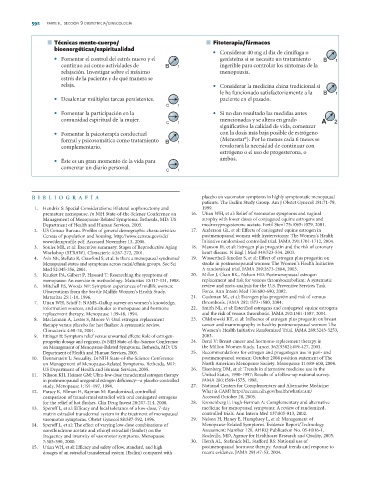Page 584 - medicina-integrativa_compress
P. 584
592 PARTE II, SECCIÓN 9 OBSTETRICIA/GINECOLOGÍA
■ Técnicas mente-cuerpo/ ■ Fitoterapia/fármacos
bioenergéticas/espiritualidad
• Considerar 40 mg al día de cimífuga o
• Fomentar el control del estrés nuevo y el genisteína si se necesita un tratamiento B B 1
continuo así como actividades de B B 1 ingerible para controlar los síntomas de la
relajación. Investigar sobre el máximo menopausia.
estrés de la paciente y de qué manera se
relaja. • Considerar la medicina china tradicional si
le ha funcionado satisfactoriamente a la B B 1
• Desalentar múltiples tareas persistentes. paciente en el pasado.
C 1
• Fomentar la participación en la • Si no dan resultado las medidas antes
comunidad espiritual de la mujer. mencionadas y se altera en grado A A
C 1 2 2
significativo la calidad de vida, comenzar
• Fomentar la psicoterapia conductual con la dosis más baja posible de estrógeno
®
formal y psicosomática como tratamiento B B 1 (Menostar ). Por lo menos cada 6 meses se
complementario. revalorará la necesidad de continuar con
estrógeno o el uso de progesterona, o
ambos.
• Éste es un gran momento de la vida para
comenzar un diario personal.
C 1
BIBLIOGRAFÍA placebo on vasomotor symptoms in highly symptomatic menopausal
patients. The Esclim Study Group. Am J Obstet Gynecol 181:71-79,
1. Hendrix S: Special Considerations: Bilateral oophorectomy and 1999.
premature menopause. In NIH State-of-the-Science Conference on 16. Utian WH, et al: Relief of vasomotor symptoms and vaginal
Management of Menopause-Related Symptoms. Bethesda, MD: US atrophy with lower doses of conjugated equine estrogens and
Department of Health and Human Services, 2005. medroxyprogesterone acetate. Fertil Steril 75:1065-1079, 2001.
2. US Census Bureau. Profiles of general demographic characteristics: 17. Anderson GL, et al: Effects of conjugated equine estrogen in
Census of population and housing. http://www.census.gov/sdc/ postmenopausal women with hysterectomy: The Women’s Health
www/demprofile.pdf. Accessed November 13, 2006. Initiative randomized controlled trial. JAMA 291:1701-1712, 2004.
3. Soules MR, et al: Executive summary: Stages of Reproductive Aging 18. Manson JE, et al: Estrogen plus progestin and the risk of coronary
Workshop (STRAW). Climacteric 4:267-272, 2001. heart disease. N Engl J Med 349:523-534. 2003.
4. Avis NE, Stellato R, Crawford S, et al: Is there a menopausal syndrome? 19. Wassertheil-Smoller S, et al: Effect of estrogen plus progestin on
Menopausal status and symptoms across racial/ethnic groups. Soc Sci stroke in postmenopausal women: The Women’s Health Initiative:
Med 52:345-356, 2001. A randomized trial. JAMA 289:2673-2684, 2003.
5. Kaufert PA, Gilbert P, Hassard T: Researching the symptoms of 20. Miller J, Chan BK,. Nelson HD: Postmenopausal estrogen
menopause: An exercise in methodology. Maturitas 10:117-131, 1988. replacement and risk for venous thromboembolism: A systematic
6. Mitchell ES, Woods NF: Symptom experiences of midlife women: review and meta-analysis for the U.S. Preventive Services Task
Observations from the Seattle Midlife Women’s Health Study. Force. Ann Intern Med 136:680-690, 2002.
Maturitas 25:1-10, 1996. 21. Cushman M., et al: Estrogen plus progestin and risk of venous
7. Utian WH, Schiff I: NAMS–Gallup survey on women’s knowledge, thrombosis. JAMA 292:1573-1580, 2004.
information sources, and attitudes to menopause and hormone 22. Smith NL, et al: Esterified estrogens and conjugated equine estrogens
replacement therapy. Menopause 1:39-48, 1994. and the risk of venous thrombosis. JAMA 292:1581-1587, 2004.
8. MacLennan A, Lester S, Moore V: Oral estrogen replacement 23. Chlebowski RT, et al: Influence of estrogen plus progestin on breast
therapy versus placebo for hot flushes: A systematic review. cancer and mammography in healthy postmenopausal women: The
Climacteric 4:58-74, 2001. Women’s Health Initiative Randomized Trial. JAMA 289:3243-3253,
9. Ettinger B: Symptom relief versus unwanted effects: Role of estrogen- 2003.
progestin dosage and regimen. In NIH State-of-the-Science Conference 24. Beral V: Breast cancer and hormone-replacement therapy in
on Management of Menopause-Related Symptoms. Bethesda, MD: US the Million Women Study. Lancet 362(9382):419-427, 2003.
Department of Health and Human Services, 2005. 25. Recommendations for estrogen and progestogen use in peri- and
10. Dennerstein L: Sexuality. In NIH State-of-the-Science Conference postmenopausal women: October 2004 position statement of The
on Management of Menopause-Related Symptoms. Bethesda, MD: North American Menopause Society. Menopause 11:589-600, 2004.
US Department of Health and Human Services, 2005. 26. Eisenberg DM, et al: Trends in alternative medicine use in the
11. Nilsson KH, Heimer GM: Ultra-low-dose transdermal estrogen therapy United States, 1990-1997: Results of a follow-up national survey.
in postmenopausal urogenital estrogen deficiency—a placebo-controlled JAMA 280:1569-1575. 1998.
study. Menopause 1:191-197, 1994. 27. National Centers for Complementary and Alternative Medicine:
12. Parsey K, Ellman H, Rajman M: Randomized, controlled What is CAM? http://nccam.nih.gov/health/whatiscam/
comparison of transdermal estradiol with oral conjugated estrogens Accessed October 28, 2005.
for the relief of hot flushes. Clin Drug Invest 20:207-214, 2000. 28. Kronenberg F, Fugh-Berman A: Complementary and alternative
13. Speroff L, et al: Efficacy and local tolerance of a low-dose, 7-day medicine for menopausal symptoms: A review of randomized,
matrix estradiol transdermal system in the treatment of menopausal controlled trials. Ann Intern Med 137:805-813, 2002.
vasomotor symptoms. Obstet Gynecol 88:587-592, 1996. 29. Nelson H, Haney E, Humphrey L, et al: Management of
14. Speroff L, et al: The effect of varying low-dose combinations of Menopause-Related Symptoms. Evidence Report/Technology
norethindrone acetate and ethinyl estradiol (femhrt) on the Assessment: Number 120. AHRQ Publication No. 05-E016-1.
frequency and intensity of vasomotor symptoms. Menopause Rockville, MD, Agency for Healthcare Research and Quality, 2005.
7:383-390, 2000. 30. Hersh AL, Stefanick ML, Stafford RS: National use of
15. Utian WH, et al: Efficacy and safety of low, standard, and high postmenopausal hormone therapy: Annual trends and response to
dosages of an estradiol transdermal system (Esclim) compared with recent evidence. JAMA 291:47-53, 2004.

